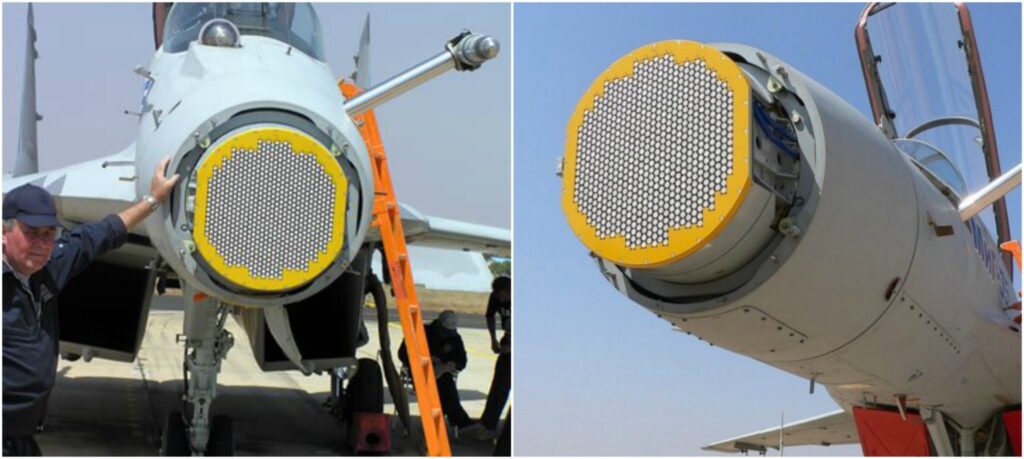By Major (R) Haroon Rasheed Defense & Strategic Analyst, Member REC-ABAD
Introduction
Airborne Electronically Scanned Array (AESA) radars have become the defining element in modern air combat. They determine who detects first, who shoots first, and ultimately — who survives. Both India and Pakistan have invested heavily in AESA technology, but the capabilities, maturity, and combat records of these systems differ significantly.
India’s latest development, the Virupaksha AESA radar, is being hailed in Indian media as a game-changer — even claimed to be superior to Chinese and Turkish systems. On the other side, Pakistan’s KLJ-series AESA radars from China are already operational and war-tested, having been deployed during real-time border tensions. This distinction between laboratory performance and combat-proven reliability is critical when assessing both sides.
National Minorities Day being observed today
2nd phase of receiving hajj applications begins
Couple denied entry at Delhi restaurant over Indian attire; CM takes note
For more such Opinions & Blogs, click here.
Indian AESA Radar — Virupaksha
The Virupaksha AESA, developed by DRDO for the Su-30MKI upgrade, features an impressive ~2,400 Gallium Nitride (GaN) TR modules and claims detection of a 1 m² target at around 600 km, and stealth targets at 200 km. It offers 4D tracking, multi-mode operation, and ECCM (Electronic Counter-Counter Measures) for anti-jamming performance.
However, Indian defence PR has a tendency to inflate specifications for strategic signalling. Past experiences with Indian indigenous systems — such as the Arjun MBT or Tejas Mk1 — show a gap between brochure figures and real-world performance. Until Virupaksha is deployed operationally and tested under combat or live-training conditions against peer threats, its true effectiveness will remain speculative.
Pakistani AESA Radars — Combat Proven
Pakistan operates two primary AESA-equipped fighter platforms
1. JF-17 Block III with KLJ-7A AESA — Estimated 1,000–1,200 TRMs, detection range ~170–200 km for 5 m² targets. Integrates with the long-range PL-15 missile (200–300 km class).
2. J-10C with KLJ-10 AESA — Estimated 1,600–1,800 TRMs, detection range ~250–300 km for 3 m² targets, advanced LPI (Low Probability of Intercept) modes, and high jamming resistance.
Both systems are combat-ready and have been used in real operational postures during heightened tensions, including missions where radar lock-ons and missile queuing were achieved against adversary aircraft. This real-world exposure means Pakistani AESAs have been validated under stress, unlike India’s Virupaksha, which is still in the evaluation phase.
Another British F-35 jet makes emergency landing in Japan weeks after India snag
Islamabad Airport not closing for eight days
6 coaches of Jaffar Express derailed after track blast
Key Comparison Table
Feature Virupaksha (India) KLJ-10 (Pakistan/J-10C) KLJ-7A (Pakistan/JF-17 B3)
TR Modules ~2,400 (GaN) ~1,600–1,800 (GaN) ~1,000–1,200 (GaN)
Max Range (Large Target) Claimed 600 km (unverified) ~250–300 km ~170–200 km
Stealth Detection Claimed ~200 km ~50–80 km ~50–70 km
Operational Status Not yet deployed Fully operational Fully operational
Combat Experience None War-tested War-tested
Missile Integration R-77/Meteor PL-15/PL-10 PL-15/PL-10
Observations
Paper vs Practice: While Virupaksha’s raw specifications suggest high potential, untested systems often face unforeseen limitations in the field. Pakistan’s AESAs, while having smaller TRM counts, benefit from proven missile integration and actual combat readiness.
Missile Pairing Matters: A radar is only as effective as the weapons it guides. Pakistan’s pairing of KLJ-series radars with PL-15 long-range missiles gives them an extended engagement envelope.
LPI & ECM Realities: Chinese AESAs in Pakistani service employ LPI waveforms, making early detection by enemy RWRs harder — a factor that brochure specs often ignore.
Operational Doctrine: PAF integrates its AESA fighters into a networked system with AEW&C aircraft, multiplying effective detection range beyond onboard radar limits.
Field Marshal holds meetings with US leadership
Death anniversary of doctor Ruth Pfau today
The next war may happen soon, and we have prepared accordingly: Indian Army Chief
Conclusion
India’s Virupaksha AESA could be a formidable sensor if its claims translate into reality, but for now it remains unproven. In contrast, Pakistan’s KLJ-series AESAs are already embedded into PAF’s warfighting doctrine, tested in operational deployments, and backed by long-range missile capabilities.
Until India’s radar is combat-proven and integrated into a complete kill chain, Pakistani AESA-equipped fighters retain an edge in real-world credibility — even if, on paper, the Indian system seems more powerful. In modern warfare, the battlefield is the only place where technology earns its reputation.
For more such Opinions & Blogs, click here.
India, Pakistan navies to hold drills just 60 nautical miles apart
Analysts ridicule Indian Air Chief’s claim of downing six Pakistani planes
Three-day hunger strike in Kargil to press for Ladakh’s political rights
India tightens military lockdown, surveillance in Kashmir ahead of I-Day
India’s move to ban 25 books in Kashmir aims to erase history: NYT
Major (R) Haroon Rasheed is a defense and strategic analyst specializing in South Asian military dynamics, deterrence strategy, and defense modernization. He is a member of the Research and Evaluation Cell for Advancing Basic Amenities and Development (REC ABAD)
Stay tuned to Baaghi TV for more. Download our app for the latest news, updates & interesting content!






